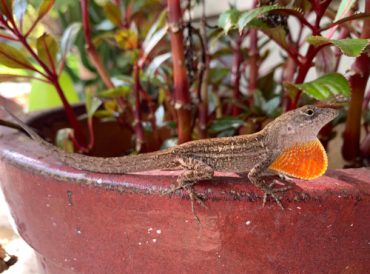

One fact of life about living in Florida is that you will see lizards pretty much every day. Specifically, you will most likely see a lizard called the Brown Anole. Other lizards do exist in our habitat, such as the Iguana, Gecko and the Green Anole, but the Brown Anole is much more numerous.
The Brown Anole is native to Cuba and the Caribbean Islands but it didn’t take long for this lizard to find its way to Florida. Once regular trade began between those islands and the Sunshine State hundreds of years ago, the population of this lizard really took off.
The Green Anole, however, is actually native to Florida and the Southeastern USA in general. But their numbers are now dwarfed by the much more plentiful Brown Anole. The Green Anole has been introduced to the Caribbean and Pacific Islands by accident, the same way the Brown Anole was introduced here. These lizards are very similar, so much so that you could call them cousin species.
The Anole, unlike the Gecko, is diurnal, meaning it is awake during the day and sleeps at night. During the day it prefers to sunbathe and look for food. It won’t travel too far in its search though. The Anole Lizard is territorial and will usually claim a small area as its own. It will eat worms and bugs including roaches and ants.
The Anole Lizard can go up to 30 days without eating before it dies of malnutrition. However, they can only last three days without water. In fact, lack of water in the number one reason an Anole Lizard will leave its area and go for a sojourn. The second reason is that if its area is crowded and the competition is larger in size, ie., big lizards vs. smaller ones.
Males are much more territorial and will fight one another to establish dominance. The males will take a high position is its area and look down at the ground, searching for food, females with which to mate with and intruding males.
If you have ever spent more than a few seconds looking at this lizard you will see that the Anole does a little dance quite regularly. Some people say it looks like they are doing push-ups. This is signaling cue to other Anole Lizards basically saying “hey, I am here.”. The males will also extend their dewlap, an orange or yellow flap of skin under the jawline that signals “I am a male. Mate with me.”. Or if the other lizard is also a male then they are signaling to each other to back off. Scientists also believe that the push-up behavior may be a way to detect even the tiniest bit of movement around them by comparing two slightly-different images in their brain.
The average Anole Lizard will live about 18 months. However, they can live up to 5 years. If they have a nice piece of land which is plentiful in food and water and do not have a lot of predators trying to eat them, they can do very well.
Predators which hunt and eat the Anole are just about anything bigger than they are. House cats, birds, larger reptiles, you name it, everything will give chase. That’s why this lizard can moves so quickly. It has the ability to travel 6 mph in short spurts. This may not seem fast but it is for a tiny reptile. And the ability to get to 6mph in just a second is a great way to evade predators. Have you ever tried to catch a healthy Anole? Its not very easy at all.
When the Anole Lizard is threatened it can detach its tail. It can do so with or without contact. If a predator tries to grab it by its tail then the tail is coming off. But the lizard has been known to detach its tails and leave it behind before a predator even gets too close. The tail may sit there and move n its own and act as a decoy. Think about it like those chaff flares you see fighter planes shooting out in demos.
The lizard can also change its color to blend into its environment. The color change isn’t as prolific as an Iguana, for instance. But it can change from light to dark and back again. It can also make its patterns more or less prominent depending on its environment. Simply, put this lizard is built to survive. And by laying six to nine eggs per year, its numbers are all but guaranteed to grow in any specific area.
